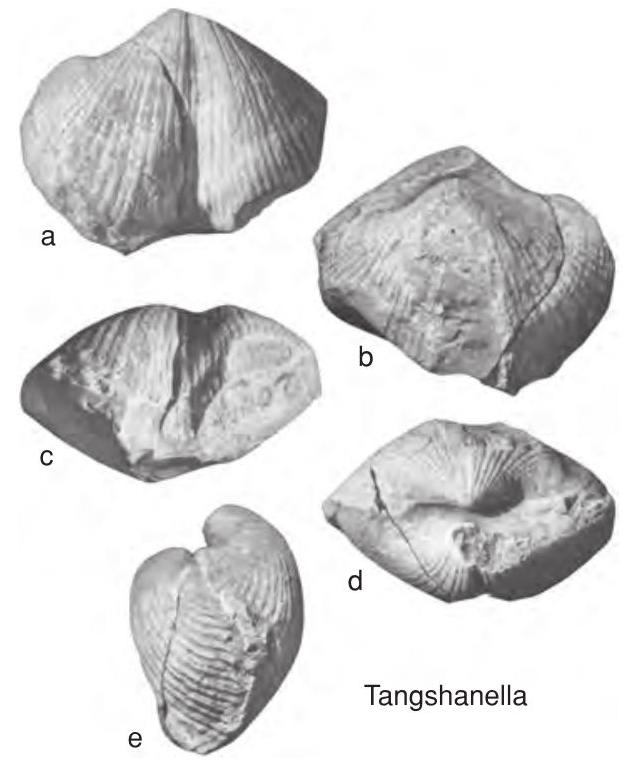Welcome to the Treatise on Invertebrate Paleontology!
Please enter a genera name to retrieve more information.

Tangshanella
Classification
Phylum:
Brachiopoda
Subphylum:
Rhynchonelliformea
Class:
Rhynchonellata
Order:
Spiriferida
Suborder:
Spiriferina
Superfamily:
Spiriferoidea
Family:
Choristitidae
Subfamily:
Tangshanellinae
Formal Genus Name and Reference:
Tangshanella CHAO, 1929, p. 57
Type Species:
T. kaipingensis, OD
Images
(Click to enlarge in a new window)
Fig. 1180 a-e. * T. kaipingensis, syntype, ventral, dorsal, anterior, posterior, and lateral views, × 1 (new).
Synonyms
Geographic Distribution
China
Age Range
Beginning Stage in Treatise Usage:
Carboniferous (Pennsylvanian)
Beginning International Stage:
Bashkirian
Fraction Up In Beginning Stage:
0
Beginning Date:
323.4
Ending Stage in Treatise Usage:
Carboniferous (Pennsylvanian)
Ending International Stage:
Gzhelian
Fraction Up In Ending Stage:
100
Ending Date:
298.89
Description
Medium size, greatest width near midlength, fold and sulcus moderately well developed, sulcus spreading anteriorly and with distinctive V-shaped profile, ventral interarea acutely triangular, entire surface multicostate, lateral slopes with few to moderately numerous bifurcations, vascular impressions unknown, externally similar to Choristites
References
Museum or Author Information
Classification
Phylum:
Brachiopoda
Subphylum:
Rhynchonelliformea
Class:
Rhynchonellata
Order:
Spiriferida
Suborder:
Spiriferina
Superfamily:
Spiriferoidea
Family:
Choristitidae
Subfamily:
Tangshanellinae
Formal Genus Name and Reference:
Tangshanella CHAO, 1929, p. 57
Type Species:
T. kaipingensis, OD
Images
(Click to enlarge in a new window)
Fig. 1180 a-e. * T. kaipingensis, syntype, ventral, dorsal, anterior, posterior, and lateral views, × 1 (new).
Synonyms
Geographic Distribution
China
Age Range
Beginning Stage in Treatise Usage:
Carboniferous (Pennsylvanian)
Beginning International Stage:
Bashkirian
Fraction Up In Beginning Stage:
0
Beginning Date:
323.4
Ending Stage in Treatise Usage:
Carboniferous (Pennsylvanian)
Ending International Stage:
Gzhelian
Fraction Up In Ending Stage:
100
Ending Date:
298.89
Description
Medium size, greatest width near midlength, fold and sulcus moderately well developed, sulcus spreading anteriorly and with distinctive V-shaped profile, ventral interarea acutely triangular, entire surface multicostate, lateral slopes with few to moderately numerous bifurcations, vascular impressions unknown, externally similar to Choristites
